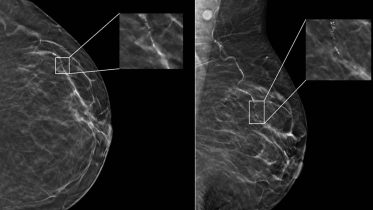Example mammogram assigned a false-positive case score of 96 in a 59-year-old Black patient with scattered fibroglandular breast density. (A) Left craniocaudal and (B) mediolateral oblique views demonstrate vascular calcifications in the upper outer quadrant at middle depth (box) that were singularly identified by the artificial intelligence algorithm as a suspicious finding and assigned an individual lesion score of 90. This resulted in an overall case score assigned to the mammogram of 96.
Credit: Radiological Society of North America (RSNA) Research reveals AI in mammography may produce false positives influenced by patient’s age and race, underscoring the importance of diverse training data. A recent study, which analyzed nearly 5,000 screening mammograms interpreted by an FDA-approved AI algorithm, found that patient characteristics like race and age impacted the rate of false positives. The findings were published today (May 21) in Radiology , a journal of the Radiological Society of North America (RSNA).

“AI has become a resource for radiologists to improve their efficiency and accuracy in reading screening mammograms while mitigating reader burnout,” said Derek L. Nguyen, M.D.
, assistant professor at Duke University in Durham, North Carolina. “However, the impact of patient characteristics on AI performance has not been well studied.” Challenges in AI Application Dr.
Nguyen said while preliminary data suggests that AI algorithms applied to screening mammogra.
















